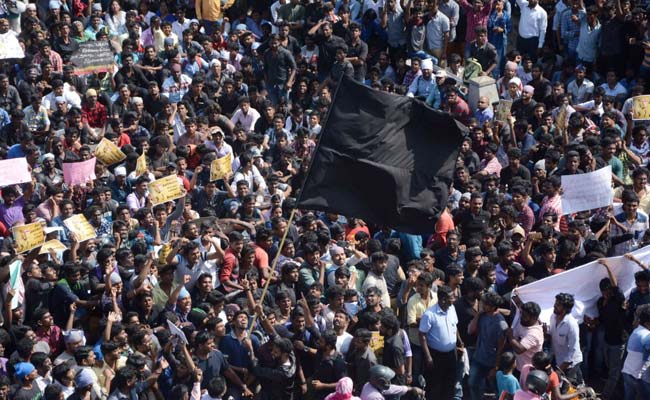Jallikattu Protests: Not Anti-National Just Anti-Establishment

CHENNAI: The huge response to what was initially a smaller protest against the ban Jallikattu is a demonstration of the burning anger amongst large sections of the people against what passes for the establishment, at both the state and the centre.
In fact the effort by New Delhi in particular to brand the protests on Marina Beach as ‘anti-national’ and ‘separatists’ has created further discontent with Tamil Nadu simmering not with secessionist tendencies but open resentment against what is being seen as the hegemony, cultural and political, of the north.
Jallikattu( bull hugging) is an ancient Tamil rural sport which is played after the harvest festival of Pongal. There are references about this sport as Eeru thaluvuthal( which means bull hugging ) in Classic Tamil Sangam literature. Even though this sport is played all over Tamil Nadu, it is quite popular and common in the southern districts of TamilNadu.
The form and content of the sport have changed in due course of time. It has assumed a commercial and fun oriented hue, leading to the call for a ban by animal welfare rights activists and NGOS like PETA, which filed a case against the sport. The Supreme Court banned Jallikattu as per the law, without taking into account the cultural sensibilities and heritage of Tamil society. There are various misconceptions about the sport, that need to be cleared by the Tamil cultural activities and the pro- Jallikattu activists. The common notion of the Tamil people is that instead of a blanket ban on it, the sport can be regulated and well-organized. They cherish it as cultural heritage.
The protest against the ban actually began in Alankanallur in Madurai district where the sport is mainly conducted by the villagers and with the support from district and tourism bodies of the government of Tamil Nadu. Later, the protest was started with a few pro—Jallikattu protesters and activists on the Marina Beach, and gradually the number of protesters started swelling. Different castes, classes, religious, rural-urban youth, children, women and senior citizens, LGBT community joined the protest. It brought in the far and wide districts of Tamil Nadu. Of course, the protest was leaderless but it was peaceful, disciplined and determined to lift the ban on Jallikattu.
Looking at the diverse nature of the gathered people, the protest was certainly more multi-dimensional than meets the eye.The various sections of the people voiced their pent up frustration through slogans and placards in a peaceful manner. There were placards for lifting the ban on Jallikattu, for a ban on multinational consumer products, seeking the release of the Cauvery waters, creation of Tamil Eelam, against demonetization, for language rights, for the protection of Tamil farmers from drought, promotion of indigenous seeds and cattle breeds, removal of NEET examinations and so on. Slogans against the Chief Minister and Prime Minister rent the air ever so often, but until the police turned there was no violence associated with the protests.
A Peoples Declaration, not covered by the so called national media in detail, was passed unanimously by the crowds gathered at the Marina Beach. The charter of demands clearly proved that Jallikattu had been linked by the masses to a host of demands such as :
-Waive all types of loans for the farmers of Tamil nadu
- Waive the loans of educational,Transport and agrucltural for the Cauvery Delta farmers.
-Close down all the TASMAC liquor shops
-Ban the illegal and smuggling of sandquarrying and mine quarrying
- Stipends for the educated unemployed youth
-Stop the construction of Atomic Power stations, and laying of Nutrino,Shell gas, Gail Gas, Methene gas connection
-Protect the livelihood of Tamil fishermen
-Free compulsory mother tongue education up to school level
-Provide compensation to the affected small scale industries due to inflation
-Give rights to the people for protecting and maintaining the local water bodies.
-Law for the conducting of Jallikattu permanently.
-Remove and ban the enacted laws against the aspirations of the majority people.
The regional and national political parties representingTamil Nadu, either ruling or in the Opposition, have clearly failed to address the aspirations of the people of the state. There has been no sustained and concrete solution for these demands that have remained unresolved for years now.
As usual the national media has selectively projected this mass gathering as ‘anti national’, indicative of ‘Tamil chauvinism’ and/or ‘Tamil separatism’ without reading the crucial fine print. Even as the police used force the protestors shouted ‘ Vande Matram,’ and Jai Hind’. Despite excessive use of of force by the police and some demands to boycott Republic Day, it was celebrated peacefully and with full participation.
The DMK and AIADMK seem to have lost the trust and confidence of the people, with a leadership crisis in both. This was indicative through the protests where neither of the two parties were involved. The youth of all sections was in the lead, keeping the crowds disciplined and manageable. Tamil society is awaiting alternative politics based on a progressive and inclusive agenda .
These protests could well be the precursor to a Tamil Nadu Spring.



